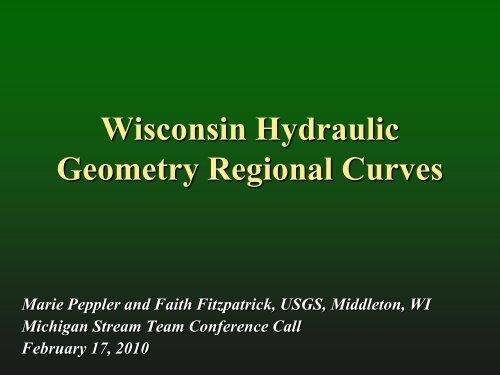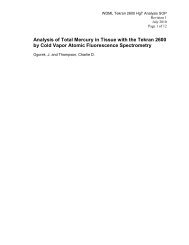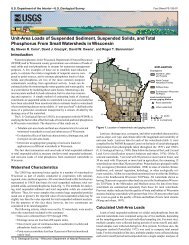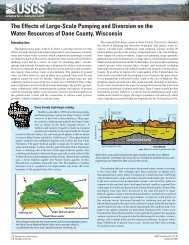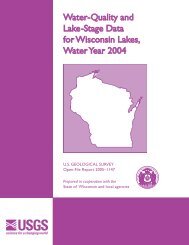Wisconsin Regional Curves Overview - USGS
Wisconsin Regional Curves Overview - USGS
Wisconsin Regional Curves Overview - USGS
You also want an ePaper? Increase the reach of your titles
YUMPU automatically turns print PDFs into web optimized ePapers that Google loves.
<strong>Wisconsin</strong> Hydraulic<br />
Geometry <strong>Regional</strong> <strong>Curves</strong><br />
Marie Peppler and Faith Fitzpatrick, <strong>USGS</strong>, Middleton, WI<br />
Michigan Stream Team Conference Call<br />
February 17, 2010
Objectives<br />
Develop relations between channel hydraulic<br />
geometry and drainage area for regions of<br />
<strong>Wisconsin</strong> and Midwest states<br />
• Describe relations in terms of multiple<br />
stressors (multiple regression similar to flood<br />
frequency regressions)<br />
• Investigate outliers (such as presence of<br />
wetlands)<br />
• Build geomorphic data set for streamgages
Cooperators/funding<br />
• started in 2006 and ongoing<br />
• Cooperative effort among <strong>USGS</strong>, U.S. Forest Service,<br />
and Natural Resources Conservation Service<br />
• U.S. Forest Service --NE WI<br />
• Natural Resources Conservation Service (MOU) – SW WI<br />
Driftless Area<br />
• <strong>Wisconsin</strong> DNR (interest but no funding yet)<br />
• Cooperation with UW Stevens Point for Driftless area<br />
and Western Lake Michigan tribs<br />
• Proposal in development for expansion across the<br />
Northern Lakes and Forests Ecoregion (MN, WI, MI)
Communication and Coordination<br />
• <strong>USGS</strong>/USFS/NRCS (and maybe WI DNR)<br />
~ bimonthly calls<br />
~ quarterly meetings<br />
~ potential site selection<br />
~ field recon<br />
~ protocol development<br />
~ final site selection<br />
~ field comparisons<br />
~ data compilation/analyses<br />
~ particle size laboratory analyses<br />
~ data sharing/archiving<br />
Regular communication with MI stream team<br />
Using modified version of Ohio <strong>USGS</strong> Modified Mecklenberg<br />
spreadsheets
Site locations
Site selection criteria<br />
• Drainage areas of less than 300 mi 2 , with majority less than 100 mi 2<br />
• Active streamgage (or current stage-discharge relation) a priority, crest<br />
stage gages are secondary<br />
• Minimum of 10 years of streamflow record, preferably 10-20 years<br />
• Alluvial setting (no bedrock channels)<br />
• No dams<br />
• Limited local effects (culvert control, channelization, restoration).<br />
Determine acceptable extent of alterations – may change as study<br />
progresses and reconnaissance is done<br />
• Observable field indicators of bankfull stage<br />
• Give preference to “stable” streams with minimal recent aggradation or<br />
incision<br />
• Rural streams (mix of forest and agriculture)<br />
• Range of Rosgen Level II channel types<br />
• Some sites that were excluded on the first pass are now being reconsidered<br />
due to the increase in record length or changes in expectations of<br />
disturbance or wetland impacts
Site Reconnaissance<br />
• Eligible sites are field checked<br />
• 7 for 12 approval rate for north region<br />
• Identify<br />
• Reach length (20+ stream widths)<br />
• Channel stability and riffle/pools<br />
• Bankfull stage indicators<br />
• <strong>USGS</strong> reference marks for gage<br />
• Field issues (special equipment,<br />
unique surveying or pebble count<br />
technique needed, etc.)<br />
• Riparian landowners<br />
• Possible local impacts<br />
Bad River at Mellen, WI
Field Methods<br />
• Surveying<br />
• Cross sections<br />
• 3 riffles<br />
• (at least one<br />
valley width)<br />
• 1 pool<br />
• 1 at stage recorder or crest stage gage<br />
• 1 at low-flow-measuring section for gage (approximately)<br />
• 1 at bridge/culvert<br />
• Cross section locations monumented with rebar<br />
• Longitudinal Profile<br />
Bois Brule River near Brule<br />
• Centerline, thalweg, edge of water, bankfull and bank top elevations on<br />
both sides though the reach (2+ stream widths us and ds of reach)
Field Methods, continued<br />
• Bed substrate<br />
• Pebble counts<br />
• One at each riffle (3) and<br />
one reach weighted<br />
(Rosgen method)<br />
• Hand texture sand samples<br />
and collect sand QA if reach<br />
is greater than 50% sand<br />
• Bank Substrate/Structure<br />
Spring Creek near Durand<br />
• Collect samples at the endpoint of each transect between<br />
the water surface and bankfull elevations<br />
• Fill out geomorphic assessment sheets (modified Thorne)<br />
for each bank
Field Methods, data sheets<br />
• Modified from Colin Thorne (UK)<br />
• Designed to collect more data than are<br />
required to generate the regional curves with<br />
only a small amount of additional field effort<br />
• Example of scanned field sheets
Data management and analysis<br />
• Five components for every site<br />
• Photos folder (recon and data collection)<br />
• Streamflow folder (5 files)<br />
• Documents and Maps (pdf of scans of everything)<br />
• 00000000_Sitename_analysis.xls (7 sheets)<br />
• 00000000_Sitename_rawdata.xls (pebble count,<br />
survey data analysis, etc.)<br />
• Example<br />
site files
Data sharing<br />
• USFS is hosting the<br />
ftp site – no security<br />
permissions problems<br />
• This has allowed<br />
rapid communication<br />
and sharing of<br />
updated files and we<br />
haven’t mixed up<br />
versions yet!<br />
• Need a longer term<br />
solution to store and<br />
share files
1,000<br />
Preliminary Bankfull Area<br />
Kickapoo<br />
N Fish<br />
Brule<br />
100<br />
Bankfull area (square feet)<br />
10<br />
Rock Br<br />
Mishonagon<br />
Pearl<br />
Price DS<br />
Price US<br />
Black Earth<br />
Spring<br />
Regression results, U.P. MI Limited Use (Buck Engineering, 2009)<br />
Regression results, L.P. MI (Rachol and Boley-Morse, 2009)<br />
Observed, this study<br />
y = 2.5976x 0.9875<br />
R² = 0.7939<br />
Power (Observed, this study)<br />
1<br />
1 10 100 1,000<br />
Drainage area (square miles)
Preliminary Bankfull Q<br />
10,000<br />
N Fish<br />
Bankfull Discharge (cubic feet per second)<br />
1,000<br />
100<br />
10<br />
Rock Br<br />
Mishonagon<br />
Pearl<br />
Price DS &<br />
Price US<br />
Black Earth<br />
Brule<br />
Kickapoo<br />
Regression results, U.P. MI Limited Use (Buck Engineering, 2009)<br />
Regression results, L.P. Michigan (Rachol and Boley-Morse, 2009)<br />
y = 18.283x 0.7023<br />
R² = 0.5757<br />
Observed, this study<br />
Power (Observed, this study)<br />
1<br />
1 10 100 1,000<br />
Drainage area (square miles)
10<br />
Preliminary Bankfull Depth<br />
N Fish<br />
Kickapoo<br />
Price DS<br />
Brule<br />
Price US<br />
Bankfull Depth (feet)<br />
1<br />
Rock Br<br />
Spring<br />
Pearl<br />
Mishonagon<br />
Black Earth<br />
Regression results, U.P. MI Limited Use (Buck Engineering, 2009)<br />
Regression results, L.P. MI (Rachol and Boley-Morse, 2009)<br />
y = 0.3552x 0.5087<br />
R² = 0.661<br />
Observed, this study<br />
Power (Observed, this study)<br />
0.1<br />
1 10 100 1000<br />
Drainage area (square miles)
Preliminary Bankfull Width
BANKFULL CHANNEL AREA (M^2)<br />
100<br />
10<br />
1<br />
Milwaukee-<br />
Green Bay<br />
urban<br />
y = 0.7435x 0.6135<br />
R² = 0.409<br />
rural<br />
y = 0.1623x 0.8555<br />
R² = 0.4371<br />
Duluth<br />
urban<br />
y = 0.7378x 0.5798<br />
R² = 0.9895<br />
Boston TIA < 6<br />
Boston TIA > 12<br />
Coastal and Central Maine (Dudley, 2004)<br />
Milwaukee-Green Bay TIA < 6<br />
Milwaukee-Green Bay TIA > 12<br />
Chicago TIA < 6%<br />
Chicago TIA > 12%<br />
<strong>Wisconsin</strong> (unpublished data)<br />
Duluth 12%<br />
Power (Milwaukee-Green Bay TIA < 6)<br />
Power (Milwaukee-Green Bay TIA > 12)<br />
Power (Duluth TIA > 12%)<br />
TIA = Total impervious area<br />
0.1<br />
0.1 1 10 100 1000<br />
DRAINAGE AREA (KM^2)
Current Issues<br />
• Coordinated data management and storage has been<br />
working well<br />
• Modified Modified Ohio Mecklenberg sheets may be<br />
template for future geomorphic data base<br />
• Need to consider procedures for archiving data and<br />
making it available to the general public<br />
• It would be great to provide the regressions in<br />
STREAMSTATS (with the flood frequency data) or the<br />
data NWIS (with the real-time flow data)? Updated Vigil<br />
Network? <strong>USGS</strong> Biological data base?<br />
• Part of the next effort (2011-13) is to develop an answer to<br />
the data conundrum (storage, sharing and public use)<br />
• Pace has been slow, but this has had its advantages<br />
for protocol development and data management
Northern Lakes and Forest Proposal<br />
• Select approximately 30-40 <strong>USGS</strong> forested streamgages from Northern Lakes and Forest<br />
Ecoregion in the Michigan Upper Peninsula, <strong>Wisconsin</strong>, and Minnesota and combine with<br />
data from existing hydraulic geometry sites previously sampled for primary analysis of<br />
bankfull characteristics and relation to drainage area and peak flow probabilities.<br />
• Use same WI <strong>USGS</strong>/ USFS/ NRCS protocols, data management, and data analysis as used for<br />
WI statewide study. Collect data in fy2011-2012, starting in the fall 2010.<br />
• Categorize channel types using Rosgen Level II classification.<br />
• Develop regional bankfull curves and flood probability. Compare relationships across Rosgen<br />
channel types.<br />
• Construct comparison plots of data from the streamgages with hydraulic geometry data<br />
collected from approximately 125 reaches with bankfull, drainage area, and channel type from<br />
previous study by Savery and others, 2001<br />
• Compare to other hydraulic geometry data collected previously at ungaged sites.<br />
• Compare to previously published hydraulic geometry/curves in adjacent areas, including<br />
Michigan’s lower peninsula.<br />
• Write proposals with federal, university, and state partners to complete regional curves in<br />
areas where gaps exist in the coverage of Great Lakes tributaries<br />
• Construct geomorphic data base for the Great Lakes tributaries
Level IV Ecoregions (Omernik, 2010)<br />
Blue areas = Units within the Northern Lakes and Forest Ecoregion
Other <strong>USGS</strong> <strong>Regional</strong> <strong>Curves</strong><br />
• 19 other <strong>USGS</strong> publications in 11<br />
states<br />
• TN is in progress<br />
• This map only includes published <strong>USGS</strong> studies<br />
• (reports by region in NY, PA, and VA)<br />
• Similar methods across most studies<br />
(see spreadsheet)<br />
• Represents a large body of data that<br />
is collected and not archived<br />
• NRCS/Nat’l Engineering Handbook has a national protocol
Summary<br />
• Working toward multi-agency procedures<br />
and methods for developing regional curves<br />
in <strong>Wisconsin</strong><br />
• Protocols and data storage ready for more<br />
wide spread use<br />
• Working on collaboration with entities in<br />
other states to develop curves for the entire<br />
Great Lakes Basin<br />
• Hope to use projects as basis for a <strong>USGS</strong><br />
geomorphic data base


